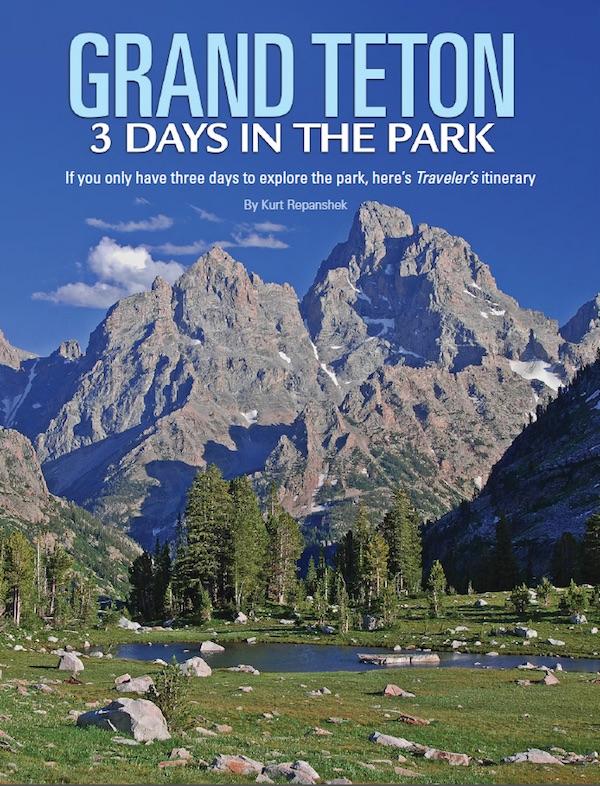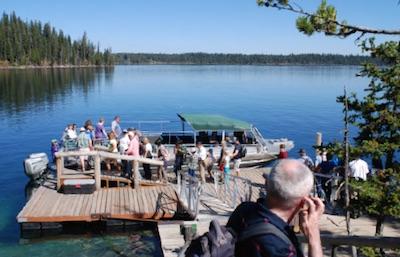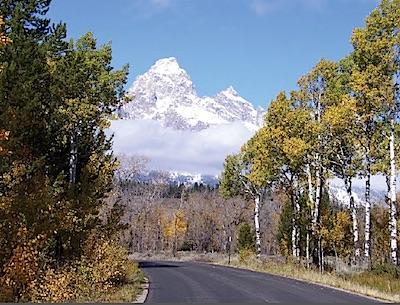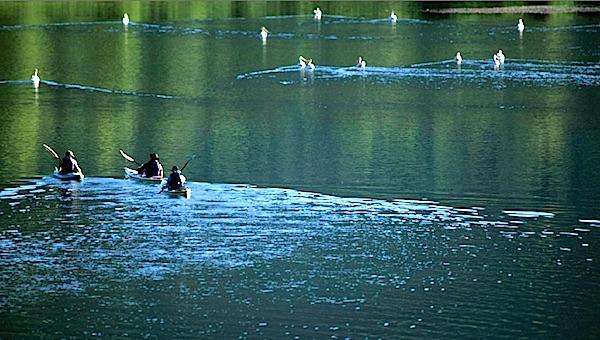
Lake Solitude is a great backcountry destination in Grand Teton, but it's not a short, easy hike/NPS
From the top of Togwotee Pass east of Jackson, the Teton Range anchors Wyoming's western horizon, its glacial horns seemingly clawing at the sky. It's a view as stunning as it is breathtaking, and one that never leaves your memory.
It's also one that makes you practically jump back into your car (after a few photographs), to continue the descent into the Jackson Hole Valley and Grand Teton National Park. There, passing through leafy cottonwood stands and sweet-scented sagebrush meadows, the mountains steadily take up more and more of your windshield. By the time you pull into the Jenny Lake parking area, they overwhelm you. But the mountains are why you came to Grand Teton, and there's lots to do besides gawk at them.
The Main Attraction
The Jenny Lake area is the top attraction in Grand Teton. More visitors head here than to any other location in the park. At least it can seem that way when you're waiting to cross the lake on a shuttle boat, or when you're hiking the trails above the lake's western shore.
But this area is too beautiful not to explore. Head out early, as early as you can, to beat the crowds. Then enjoy the 2.5-mile hike around the south end of the lake, savoring the cool morning air, the sunshine splashed across both the lake and the Tetons.

You can walk around Jenny Lake to head up into the mountains, or take a relaxing cruise across the lake. Trails lead you up, and over, Cascade Creek to reveal panoramic views of the park/Kurt Repanshek
And then head into the mountains. The trail system, along with the Hidden Falls and Inspiration Point areas, are being rehabbed in most places, and rebuilt in a few, in advance of the National Park Service Centennial next year. The result is a much smoother, and when possible leveler, tread underfoot. (The work is not finished just yet, so watch your footing where it's not and enjoy the areas that have been completed.)
At Hidden Falls, enjoy the crashing waterfall and the cooling mist. Make it to the top of Inspiration Point and you've sweeping views of not just Jenny Lake down below but the entire Jackson Hole Valley.
You could spend all day in the mountains -- take a long hike to Lake Solitude, a 19-mile roundtrip trek that really gets you into the backcountry with fantastic views -- or head back down and hike around Jenny, String, and Leigh lakes.
Wherever you head, if you're coming to the park from lower elevations keep in mind the altitude here -- the valley floor is roughly 6,000 feet, and the Tetons soar 7,000 feet up from there! It might take you a day or two to acclimate, so take it easy at first.
Gain Some Perspective
The Rockefeller family had an enormous role in seeing Grand Teton National Park established. Early in the 20th century, John D. Rockefeller, Jr. worked hard to buy up private holdings that might have prevented the preservation of the landscape you see today.
One of his sons, Laurance S. Rockefeller, continued the family's legacy of giving to, and helping create, national parks when he donated a family ranch to the park. Today, the Laurance S. Rockefeller Preserve sprawls over 1,100+ rumpled acres of Teton mountainside, offering you 8 miles of hiking trails to explore.
If you want a break from hiking, head into the preserve's interpretive center and explore the interactive exhibits -- Mr. Rockefeller discussing his views on conservation, high-definition nature videos, large-scale photography, and a soundscape room with nature recordings -- to gain a better understanding of the park.
Youngsters 6-12 can borrow a Nature Explorer's Backpack that includes a nature journal and head out onto the trails to begin their naturalist's career.

Spend a day exploring the Moose-Wilson Road that winds through the forests in the park's southwestern corner/NPS photo
From the center, you can hike 1.1 miles up to Phelps Lake, and then circle the lake (roughly 3.6 miles), or continue farther up Death Canyon on a trail that takes you past sheer cliffs of the north face of Prospectors Peak and Albright Peak.
If you encounter a rainy day, sit in front of the fire inside the center with some of the available interpretive materials.
While here in the southwestern corner of the park, take a slow drive on the Moose-Wilson Road. Along with pastoral views of the Snake River and its embracing wetlands, you might spot moose or bears, along with waterfowl and perhaps some wading birds, such as herons. Be sure to watch for the beaver lodge and the pond it created.
The roadsides here are lush with vegetation bursting with succulent berries in early fall. As a result, the road corridor is popular with black bears anxious to add a few pounds before winter sets in.
To wrap up the day, head from Wilson back through Jackson and stop at the National Museum of Wildlife Art just north of town. It contains some magnificent artworks from such notables as Charles Russell, George Catlin, Albert Bierstadt, and Maynard Dixon.
Ready for a break from hiking?
You can sign up at the Colter Bay Marina for a scenic cruise on Jackson Lake, rent a canoe from the marina to explore the lake on your own, enjoy a few hours floating the Snake River with one of the park concessionaires, or simply cool off at the beach by the Colter Bay picnic area and relax with a book or nap.
To gain an appreciation for the park's history, visit the Menor's Ferry Historic District with its original general store and see where a ferry long worked to haul passengers, livestock, and freight across the Snake River. Nearby, take time to tour the Maud Noble cabin, where on July 26, 1923, a meeting among park proponents -- including future National Park Service Director Horace Albright -- was held to discuss creation of Grand Teton National Park.
From there, head over to the Murie Ranch, where Olaus, Mardy, Adolph and Louise Murie spawned the modern conservation movement in the 1950s. Their efforts led to passage of The Wilderness Act in 1964.
Looking for wildlife to fill your camera? Stop by the Oxbow Bend Overlook or head down to the Cattleman's Bridge Site and you'll likely spy pelicans, osprey, possibly bald eagles, and other birdlife. Not far away, you can often spot bison and pronghorn on Antelope Flats on the east side of U.S. Highway 191/89/26.
If you're interested in a more extensive wildlife safari, Teton Science Schools, a non-profit, offers wildlife expeditions in Grand Teton throughout spring, summer and fall. Their guides are well-versed in the natural history of the park, and provide wonderful running commentaries as you move around the park.
Throughout the tour you might see a bull elk pushing his harem of cows across the sagebrush flats beneath the steely Grand Teton, a bald eagle roosting atop a snag overlooking the Snake River, bison and trumpeter swans, moose and white pelicans, sandhill cranes and pronghorn antelope.
Or, you could take your own wildlife expedition on two wheels. A multi-use path runs alongside the Teton Park Road from Moose to Jenny Lake; take to it on your own bike, or rent one from Adventure Sports at Dornans in Moose.
While this is a good introduction to Grand Teton, the many trails to explore, historic sites to see, and calm, pastoral settings to enjoy invite longer stays in this icon.

Paddling the Snake River at Oxbow Bend, or simply soaking in the view of the Tetons and Skillet Glacier, make the Oxbow Bend area a mandatory stop on your Grand Teton vacation/Patrick Cone



Comments
Great article Kurt! It reminded me of some of my favorite things in Grand Teton National Park, one of my favorite parks in the NPS.
Thank you for sharing and helping me to plan my trip with your wonderful insights :) God bless!
One of our favorites is the breakfast on Elk Island reserved out of Colter Bay! Wonderful scenery, excellent breakfast cooked on the island! Try it, you won't be disappointed!
It's so great to know that we have such beautiful,peaceful sites in our country that have not been ruined by commercialization like a lot of our country and cities have.